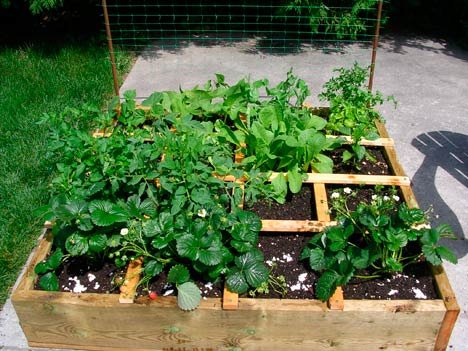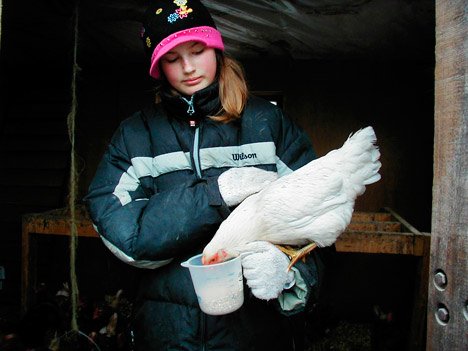
Heading into the planet’s high holiday season amid a growing sea of greenwash and cynicism, there is one earth-friendly behavior that climbs up to-do lists like no other – eating local. It’s one of the few daily moves that connects us directly to the land beneath our feet. And it allows us to literally taste the bright green economy politicians aren’t talking about, but that the majority of Canadians are embracing at cash registers, farmers markets, in their backyards and beyond.
But in a world where big brand mayo companies are pushing their locavore roots and ‘prepared (but not really grown) in Canada’ labels still prevail, we’ve got to cut through the noise. To help you freshen up your locavore diet we’re feeding you nine freshly-picked ideas that source no further than 100 miles from your front door and grow as close 10 feet from your back steps.
GROW YOUR OWN EDIBLE FOREST GARDEN
Think you can’t mimic forest ecosystems just because you have a wee balcony or tiny backyard? Wrong. Try using the tiered and polyculture principles of woodlands by reproducing a forest’s seven layers: a canopy layer (skip this on patios) a low tree layer (dwarf fruit trees) a shrub layer (berry or rosemary bush) a herbaceous layer (leafy greens like kale, swiss chard) rhizosphere (root veggies) ground cover (strawberries, oregano) and finally vertical climbing vines (beans, zucchini). For container forest gardens, combine a few layers in one pot. And don’t forget forest-loving ‘shrooms. Young Urban Farmers (youngurbanfarmers.com) sells shiitake logs that you can stick in a shady spot, even on a balcony. For all the dirt on making your edible forest paradise, go to edibleforestgardens.com.

SAY YES TO YARD-SHARING
You can’t always get what you want (like, say, a big, sunny yard), but if you sign up for yard-sharing, holy Jagger, you get what you need. Just jump onto sharingbackyards.com, where deprived green thumbs get to link up with people who actually have a back- or front-yard patch but lack the time, energy or know-how to get their hoe on. The site plays matchmaker in over 400 municipalities and offers up lots of yards across the T Dot. West-enders can also check out the Stop Community Food Centre’s fab Yes In My Back Yard (YIMBY) program. These folks are hands-on connectors, offering up a tool-lending library, free gardening workshops and seedlings, and more.

BE AN URBAN FORAGER
Though all sorts of waste saviours jump on the title, I’m not telling you to be become a full-on dumpster-diving freegan (not that there’s anything wrong with that). Rather, it’s time we opened our eyes and taste buds to the fruits of our city. No, urban foraging won’t score you morels, garlic leeks or cattail hearts like a day trip north, but we do have plenty of fruit trees cascading onto public property. If you spot mulberries, service berries, sour cherries or apples going to waste, don’t be shy. Ring that doorbell and ask permission to harvest a little before they go bad. Better still, volunteer with Not Far From the Tree (notfarfromthetree.org), where all fruit-picking bounty is split three ways: one-third to the tree owner, one-third to volunteers and one-third to shelters and food banks. Not bad, considering that 19,695 pounds of fruit was picked last year. PS: To create more foraging potential for the future, learn how to lob seed bombs, guerrilla-gardening style, at wikihow.com/make-a-seed-bomb.

UNEARTH 100-MILE CALLALOO
Pining for more than just plain carrots and potatoes? Craving ingredients from your motherland that don’t have to travel 10,000 kilometres to get here? The Toronto Environmental Alliance has smartly mapped out the freshest multicultural foods grown in Ontario’s own greenbelt. Free guides to Middle Eastern, South Asian, Chinese and African/Caribbean foods pinpoint the closest farmers’ markets, food retailers and farms that sell locally grown vine leaves, okra, bitter melon, molokhia and much more. Bonus: since they’re fresh-picked, they pack way more vitamins than produce that sat on ships, trains and trucks for weeks.

PLEDGE A TENNER TO LOCAL FOOD PLUS
Going local’s nice and all, but lots of factory farms sit on Ontario soil. Plenty of Ontario-grown soy is genetically modified, and millions of local chickens are regularly drugged up. So how can you know that the local you’re buying is truly people-, planet- and animal-friendly? Look for the Local Food Plus revamped Certified Local Sustainable seal on jars, packages, produce signs and menus. Pledge to shift even just $10 a week to Certified Local Sustainable food and you’ll be supporting “fare that’s fair” on every front, from production, animal welfare, energy use, labour rights, habitat protection and way more. For a map of who’s serving and selling LFP-approved food near you, go to localfoodplus.ca/buy-to-vote and take the pledge. Just 4,000 people pledging $10 a week to this green-economy booster creates 40 new jobs and takes nearly 400 cars’-worth of greenhouse gases off the dinner table.

COMMUNE WITH YOUR INNER CAVEMAN
Vegans aren’t going to like this, but fans of the paleolithic diet claim it’s one of the greenest around. Okay, so sticking to wild game and foraged fruit is pretty far-fetched (and not necessarily green-lit by docs), but a diet of free-range meat with healthy helpings of local chem-free fruits, veggies, eggs and nuts will certainly appeal to all those chefs and T Dotters drooling over the current carnivorous trends. No self-respecting paleolithic ancestor would have bitten into factory-farmed meat, so look for regionally raised, grass-grazing options from the most conscious of producers.
DIG DEEP FOR LOCAVORE VEGANS
Honestly, it’s easy to be a locavore if you eat eggs and cheese. Take those out, though, and protein sources start to come from farther afield. Yes, vegans have a naturally low-carbon footprint, but if all your produce and protein is imported and fossil-fuel-fertilizer-drenched, as non-organics are, you’re adding some bloat. Too many of our beans come from Cali, and our tofu comes from genetically modified soybeans. Luckily, a handful of vegan-friendly proteins are grown closer to home. Did you know that chickpeas are one of the fastest-growing Canadian food products? To get Ontario-grown beans, head to shops like Karma Coop, Culinarium and food boxes like Front Door Organics. For 100-mile, GMO-free, organic soy products (which should always be eaten in moderation), stick with Ying Ying and SoL Cuisine’s tofu (not soy-protein-based) offerings.

EAT YOUR WEEDS
Now that spring has sprung, it’s time to celebrate the arrival of your first edible crop: dandelion weeds! Sure, our lawn fetish has fostered serious bad blood between us and those bright-yellow wonder plants, but let’s not forget that they’re a rich source of minerals and vitamins A, C, K and B complex. They’re also fantastic for liver, gallbladder and kidneys. So when young dandelion heads start to plot their takeover, don’t douse them in weed killer (however natural it is). Rejoice at your zero-effort, 100-foot food source and use the leaves raw in salads or sautéed with garlic. Use their roots, too (though not if you suspect a previous tenant or owner flouted Toronto’s pesticide ban). Roast your washed and finely ground roots for two hours at 250 degrees to brew up a DIY dandelion-root coffee.

ADOPT A FARMER
One of the most feel-good ways of crunching on local cukes involves fostering a farm (or collective of farms). Yessiree, with community-supported agriculture, you pay for a growing season of local farm-fresh produce upfront (the financial security blanket) in exchange for a basket of fresh-picked love delivered to your ‘hood once a week. The concept has exploded since we first told you about CSAs like Plan B Organic. There are now a good dozen CSAs delivering to various nabes across TO, including originals like chickabiddyacres.com in the Annex and West Queen West, and newer faces like ontarioartisanshare.ca’s 100-mile foodie baskets (think cheese, meat, produce) north of St Clair. But the biggest ground-breakers are actually harvesting right under our noses. Young Urban Farmers’ non-profit CSA plucks rapini and kohlrabi from yards in Riverdale, Wychwood and Lawrence Park North. FoodCycles city farm (foodcycles.org) sows its own non-profit seeds in Downsview Park. To dig up the right foster farm for you, snoop around csafarms.ca.
ecoholic@nowtoronto.com












